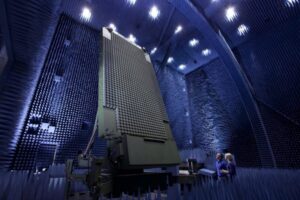SYRACUSE, N.Y. – Lockheed Martin [LMT] said Monday the company’s first TPY-4 radar, which the Air Force recently selected as its new long-range radar, will soon move to its Cazenovia, New York facility for 15 months of open-air testing.
Along with the self-funded initial radar system, Lockheed Martin is now under contract to produce the first two TPY-4 radars for the Air Force’s Three-Dimensional Expeditionary Long-Range Radar (3DELRR) program to replace its legacy TPS-75 radar.

During a recent media visit here, reporters saw the first TPY-4 radar housed in an anechoic chamber at the company’s facility, where officials are able to gather data on the system’s performance in a controlled environment before the next phase of testing.
“The anechoic chamber is effectively a [radio frequency]-neutral environment where you shut the door, the energy the radar transmits doesn’t get out and nothing gets in from the outside. So you have a very pure, clear environment in which to measure the signals the radar transmits and to drive signals very cleanly into the radar to make sure that our electronics behave and perform the way we designed them. So when we take it out into the real world, we have that base foundation to prepare against,” Rick Herodes, Lockheed Martin’s program director for ground-based air surveillance radars, told reporters.
The TPY-4 radar has been in the anechoic chamber for about a month, according to Herodes, adding the chamber is one of the largest in the defense industry.
The Air Force announced in March that Lockheed Martin beat out Northrop Grumman [NOC] to provide the new 3DELRR radar, after both companies had received integration contracts under the preceding SpeedDealer program (Defense Daily, March 11).
Lockheed Martin officially received the first production order for two TPY-4 radars on March 29, with the 3DELRR program including options to potentially provide up to 35 of the new radars.
Chandra Marshall, Lockheed Martin’s vice president of radars and sensor systems, told reporters the software-enabled nature of TPY-4 will allow for the Air Force to more seamlessly upgrade the radar as the mission set evolves.
“The threats are continuously changing, so that [software] capability allows [the customer] to not have to send back the system for us to upgrade the hardware for them to defend against new threats. You update the software, push it to the radar and you’re able to meet the missions that they have to meet. Sending the system back and changing the hardware is very costly and it’s something that we’re very mindful of when we design our systems,” Marshall said.
Herodes also cited the TPY-4’s “individual controllability” as a key capability, adding that each of the transmission nodes, or “pucks,” on the platform is “essentially an independently-controllable radar.”
“We can change how the radar transmits and receives so that part of the antenna can do one thing and another part do another thing. Or, if the customer recognizes that it’s got a different kind of a threat, we can examine that threat, do an analysis and change the software to transmit differently or, on receive, we can listen differently once we transmit and it’s reflected off of the object,” Herodes said.